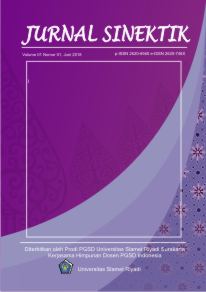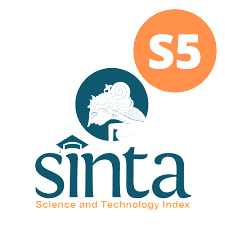KEEFEKTIFAN MODEL PEMBELAJARAN AIR (AUDITORY INTELLECTUALLY REPETITION) TERHADAP HASIL BELAJAR TEMA 6 SISWA KELAS V
DOI:
https://doi.org/10.33061/js.v3i2.3941Keywords:
Auditory Intellectualy Repetition (AIR), Learning OutcomesAbstract
This study aims to determine the effectiveness of the Auditory Intellectualy Repetition (AIR) learning model on the learning outcomes of the theme of 6th grade students of SDN Bumiharjo 02 Pati Regency. This type of research is quantitative in the form of Pre Experimental Design, with the design of One Group Pretest Posttest Design. In this study using a sampling technique that is saturated all students in grade V. Data collection techniques used were interviews, tests, observations, and documentation. Learning outcomes in the study are the pretest value of 59.869565 and with an increase in the average posttest value of 84.347826. T Test results obtained tcount more than ttable (0.173> 0.104) then H0 is rejected and Ha is accepted. So, the conclusion is that the Auditory, Intellectually, Repetition (AIR) learning model is effective on the learning outcomes of the theme of the 6th grade students of SDN Bumiharjo 02 Pati Regency.
References
Indonesia, R. 2003. Undang-Undang Nomor 20 Tahun 2003 tentang Sistem Pendidikan Indonesia. In indonesia.
Linuwih. S. 2014. Efektivitas Model Pembelajaran Auditory Intellectualy Repetition (AIR) Terhadap Pemahaman Siswa Pada Konsep Energi Dalam. Jurnal Fisika Indonesia. Volume 10 No.2.
Parwati, Ni Nyoman dkk. 2018. Belajar dan Pembelajaran. Depok : Rajawali Pers.
Permendikbud nomor 22 tahun 2016 Tentang Standar Proses.
Setianingsih, Eka Sari & Rahmat Rais. 2018. Buku Ajar Strategi Belajar Mengajar. Semarang: UPGRIS.
Shoimin, Aris. 2014. 68 Model Pembelajaran Inovatif dalam Kurikulum 2013. Yogyakarta: Ar-Ruzz Media.
Subyantoro. 2013. Teori Pembelajaran Bahasa. Semarang : UNNES PRESS
Downloads
Published
Issue
Section
License
Copyright (c) 2020 JURNAL SINEKTIK

This work is licensed under a Creative Commons Attribution-NonCommercial 4.0 International License.
Authors who publish this journal agree to the following terms:
- Authors retain copyright and grant the journal right of first publication with the work simultaneously licensed under a Creative Commons Attribution License that allows others to share the work with an acknowledgement of the work's authorship and initial publication in this journal.
- Authors can separately make additional contractual arrangements for non-exclusive distribution published by the journal (e.g., publish it in a book), with an acknowledgement of its initial publication in this journal.
- Authors are allowed and encouraged to send their work via online (e.g., in the institutional repositories or their website) after published by the journal.














